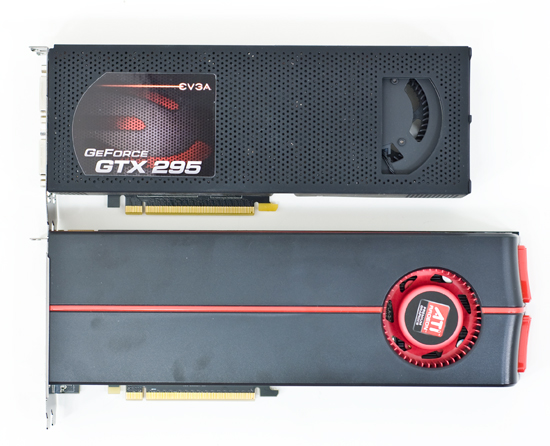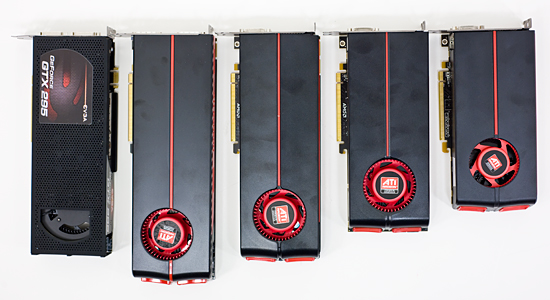The Radeon HD 5970: Completing AMD's Takeover of the High End GPU Market
by Ryan Smith on November 18, 2009 12:00 AM EST- Posted in
- GPUs
Meet The 5970
To cool the beast, AMD has stepped up the cooler from a solid copper block to a vapor chamber design, which offers slightly better performance for large surface area needs. Vapor chambers (which are effectively flat heatpipes) have largely been popularized by Sapphire, who uses them on their Vapor-X and other high-end series cards. This is the first time we’ve seen a vapor chamber cooler on a stock card. AMD tells us this cooler is design to keep up with 400W of thermal dissipation.

With the need for such a cooler, AMD has finally parted with their standard 5000 series port configuration in order to afford a full slot to vent hot air. In place of the 2xDVI + HDMI + DisplayPort configuration, we have 2xDVI + MiniDisplayPort, all on one slot. MDP was just approved by the VESA last week, and is identical to DisplayPort in features, the only difference is that it’s smaller. This allows AMD to continue offering Eyefinity support, and it also conviently solves any questions of how to plug 3 monitors in, as there are now only as many DVI-type ports as there are available TMDS encoder pairs.

Finally, as dual-GPU cards are always bigger than their single-GPU brethren, and the 5970 is no exception to this rule. However the 5970 really drives this point home, being the largest video card we’ve ever tested. The PCB is 11.5” long, and with the overhang of the cooling shroud, that becomes 12.16” (309mm). This puts it well past our previous record holder, the 5870, and even father ahead of dual-GPU designs like the 4870X2 and GTX 295, both of which were 10.5”. The only way to describe the 5970 is “ridiculously long”.

With such a long card, there are going to be some definite fitting issues on smaller cases. For our testing we use a Thermaltake Speedo case, which is itself an oversized case. We ended up having to remove the adjustable fan used to cool the PCIe slots in order to make the 5970 fit. On a smaller and more popular case like the Antec P182, we had to remove the upper hard drive cage completely in order to fit the card.
In both cases we were able to fit the card, but it required some modification to get there, and this we suspect is going to be a common story. AMD tells us that the full ATX spec calls for 13.3” of room for PCIe cards, and while we haven’t been able to find written confirmation of this, this seems to be correct. Full size towers should be able to accept the card, and some mid size towers should too depending on what’s behind the PEG slot. However – and it’s going to be impossible to stress this enough – if you’re in the market for this card, check your case

GTX 295, 5970, 5870, 5850, 5770
On a final note, while the ATX spec may call for 13.3”, we hope that we don’t see cards this big; in fact we’d like to not see cards this big. Such a length is long enough that it precludes running a fan immediately behind the video card on many cases, and quite frankly at a 294W TDP, this card is hot enough that we’d feel a lot better if we had a fan there to better feed air to the card.










114 Comments
View All Comments
Zool - Wednesday, November 18, 2009 - link
So yes. The answer is that the gpu is doing less work with vsync than without it.(dam still no edit button)Yojimbo - Wednesday, November 18, 2009 - link
The plural for a casting/shaping instrument "die" is "dies" not "dice."Lennie - Wednesday, November 18, 2009 - link
I am going to post this again here. Thought it may not get noticed since I posted it first as a reply in previous pages. Hope I wont hurt anyones feelings :)I thought everyone knew about Furmark and ATi by now. It used to be like this on 4870 series too.
It went like this, at first there were few reports of 4870(X2) cards dying when running Furmak. Further investigation showed that it was indeed Furmark causing VRM's to heat up to insane levels and eventually killing them. Word reached ATi from that point on ATi intentionally throttles their card when detecting Furmark to prevent the damage.
Yeah in fact the amount of heat load Furmak puts on VRMs is unrealistic and no game is able to heat up the VRMs to the level Furmark does. OCCT used the same method (or maybe even integrated Furmark) to test for stability (in their own opinion ofc)
So beware about Furmark and OCCT if you have HD4K or 5K.
The term "Hardware Virus" is rightfully applicable to Furmark when it comes to HD4K (and 5K perhaps)
Lennie - Wednesday, November 18, 2009 - link
I want to add that VRM overheating is quite tricky, since normally people only check on GPU temps.When you run Furmark you would notice that GPU temps are in acceptable range while at the same time your VRM's are cooking without you knowing about it.
So remember to always check your VRM temps when running graphics stability tests like Furmark or OCCT's graphics test specially when you're overclocking the card.
I use Riva or Everest to check on VRM temps.
Rajinder Gill - Thursday, November 19, 2009 - link
The temp reading that is displayed by Everest is an averaged figure. The junction temp of the slaves is the critical issue. Even though the average temp may appear to be within bounds, there is the possibility that one of the slaves may be running abnormally. Volterra keep their specifications under NDA. What I do know is that the general configuration if one slave shuts down is that the remaining slaves take the load. The result is not usually pretty. I think ATI may have implemented throttling to prevent the kind of burnouts users experienced running OCCT GPU tests on the last gen.Personally, I think the 3 phase Volterra solution used on the 5970's is right on the hilt for current draw (circa 135 amps per GPU). I'd wait for non reference solutions with enhanced power delivery if you plan on overclocking this card long term or plan to stress it heavily when OC'd).
Later
Raja
Rajinder Gill - Thursday, November 19, 2009 - link
I should add that I'm assuming ATI used the biggest Volterra slaves rated at 45 amps each and not the 35/40 amp varieties.thebeastie - Wednesday, November 18, 2009 - link
Any one that has a clue is buying a proper case like the Storm Sniper Black Edition and fitting this with heaps of space to spare.Also I recommend a case with positive or at least neutral are flow.
The storm sniper has a dust filter on its 20cm side fan to push more air in and aid in the GPU fans air flow that will go out the back of the cards vent holes at the DVI ports.
at80eighty - Wednesday, November 18, 2009 - link
Plan on getting one of these in another 7-8 months - The way I see it, despite being bleeding edge - ATI has a deadlock winner in this card and will produce only limited quantities so I'm kind of 'worried' about the availability & price down the lineSilverforce11 - Wednesday, November 18, 2009 - link
Wait til the end of December. Apparently the yeilds of cyrpress are going to be improved a lot then, so the prices will either remain the same or be lower a bit.However, since nV has nothing real for a long time, i dont foresee a drop in prices on ATI parts. Given the estimates, NV will have fermi out in april 2010, but not in significant quantities for a while after that. Im gonna grab a 5970 around xmas. :)
at80eighty - Wednesday, November 18, 2009 - link
Dude I hate you already :p I just bought a 5750 - I dont have the necessary components that would not bottleneck the 5970, so I'm going to have to wait a while. plus the whole 3 new monitors thing for the Eyefinity